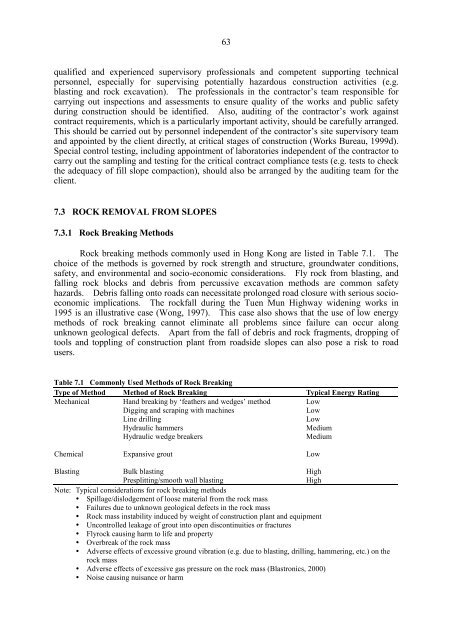Highway Slope Manual
Highway Slope Manual
Highway Slope Manual
Create successful ePaper yourself
Turn your PDF publications into a flip-book with our unique Google optimized e-Paper software.
63<br />
qualified and experienced supervisory professionals and competent supporting technical<br />
personnel, especially for supervising potentially hazardous construction activities (e.g.<br />
blasting and rock excavation). The professionals in the contractor's team responsible for<br />
carrying out inspections and assessments to ensure quality of the works and public safety<br />
during construction should be identified. Also, auditing of the contractor's work against<br />
contract requirements, which is a particularly important activity, should be carefully arranged.<br />
This should be carried out by personnel independent of the contractor's site supervisory team<br />
and appointed by the client directly, at critical stages of construction (Works Bureau, 1999d).<br />
Special control testing, including appointment of laboratories independent of the contractor to<br />
carry out the sampling and testing for the critical contract compliance tests (e.g. tests to check<br />
the adequacy of fill slope compaction), should also be arranged by the auditing team for the<br />
client.<br />
7.3 ROCK REMOVAL FROM SLOPES<br />
7.3.1 Rock Breaking Methods<br />
Rock breaking methods commonly used in Hong Kong are listed in Table 7.1. The<br />
choice of the methods is governed by rock strength and structure, groundwater conditions,<br />
safety, and environmental and socio-economic considerations. Fly rock from blasting, and<br />
falling rock blocks and debris from percussive excavation methods are common safety<br />
hazards. Debris falling onto roads can necessitate prolonged road closure with serious socioeconomic<br />
implications. The rockfall during the Tuen Mun <strong>Highway</strong> widening works in<br />
1995 is an illustrative case (Wong, 1997). This case also shows that the use of low energy<br />
methods of rock breaking cannot eliminate all problems since failure can occur along<br />
unknown geological defects. Apart from the fall of debris and rock fragments, dropping of<br />
tools and toppling of construction plant from roadside slopes can also pose a risk to road<br />
users.<br />
Table 7.1 Commonly Used Methods of Rock Breaking<br />
Type of Method Method of Rock Breaking<br />
Mechanical Hand breaking by ‘feathers and wedges' method<br />
Digging and scraping with machines<br />
Line drilling<br />
Hydraulic hammers<br />
Hydraulic wedge breakers<br />
Typical Energy Rating<br />
Low<br />
Low<br />
Low<br />
Medium<br />
Medium<br />
Chemical Expansive grout Low<br />
Blasting<br />
Bulk blasting<br />
Dresplitting/smooth wall blasting<br />
High<br />
High<br />
Note: Typical considerations for rock breaking methods<br />
• Spillage/dislodgement of loose material from the rock mass<br />
• Failures due to unknown geological defects in the rock mass<br />
• Rock mass instability induced by weight of construction plant and equipment<br />
• Uncontrolled leakage of grout into open discontinuities or fractures<br />
• Flyrock causing harm to life and property<br />
• Overbreak of the rock mass<br />
• Adverse effects of excessive ground vibration (e.g. due to blasting, drilling, hammering, etc.) on the<br />
rock mass<br />
• Adverse effects of excessive gas pressure on the rock mass (Blastronics, 2000)<br />
• Noise causing nuisance or harm

















